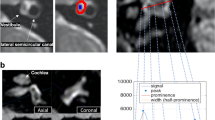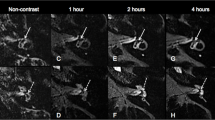Abstract
Purpose
3D-FLAIR sequences with delayed acquisition after contrast medium injection have demonstrated new insights into blood-labyrinthine barrier (BLB) abnormalities in various diseases. The aim of this study was to assess the BLB in patients referred with unilateral acute vestibular syndrome (UAVS).
Materials and methods
In this retrospective multicenter imaging study, we performed 3D-FLAIR and steady-state free precession (SSFP) sequences 4 h after contrast medium administration in 26 healthy volunteers and in 30 patients with UAVS. Two radiologists, blinded to the clinical data, independently assessed the asymmetrical enhancement of the labyrinthine structures and the vestibular nerve on 3D-FLAIR sequences, and the signal of the labyrinthine structures on SSFP sequences. Inter-reader agreement tests were performed.
Results
An asymmetrical enhancement of the semicircular canals was observed in 26 out of 30 ears (86.6%, p < 0.001) and never observed in healthy subjects. An asymmetrical enhancement of the vestibular nerve was never observed in either patients or healthy subjects. An asymmetrical enhancement of the cochlea was observed on the 3D-FLAIR sequence in 6 out of 30 ears only in the patients’ group (20%, p = 0.03) and always associated with an enhancement of at least one semicircular canal. A low signal on SSFP sequences was observed only in 11 out of 30 symptomatic ears (36.7%, p < 0.001), involving the utricle in 7 ears and the superior semicircular canal in 4 ears.
Conclusion
Patients with typical UAVS presented with semicircular canal enhancement on MRI, while an asymmetrical enhancement of the vestibular nerve was not displayed.
Trial registration
NCT02529475
Key Points
• Patients with typical vestibular neuronitis presented with semicircular canal enhancement on MRI in 87% of cases.
• An enhancement of the vestibular nerve was never displayed.





Similar content being viewed by others
Abbreviations
- BLB:
-
Blood-labyrinthine barrier
- MD:
-
Menière’s disease
- SSFP:
-
Steady-state free precession
- UAVS:
-
Unilateral acute vestibular syndrome
References
Brandt T, Dietrich M, Strupp M (2005) Vertigo and dizziness: common complaints. Springer, London
Greco A, Macri GF, Gallo A et al (2014) Is vestibular neuritis an immune related vestibular neuropathy inducing vertigo? J Immunol Res:1–8. https://doi.org/10.1155/2014/459048
Strupp M, Jäger L, Mûller-Lisse U, Arbusow V, Reiser M, Brandt T (1998) High resolution Gd-DTPA MR imaging of the inner ear in 60 patients with idiopathic vestibular neuritis: no evidence for contrast enhancement of the labyrinth or vestibular nerve. J Vestib Res 8:427–433
Byun H, Chung JH, Lee SH, Park CW, Park DW, Kim TY (2018) Clinical value of 4-hour delayed gadolinium-enhanced 3D FLAIR MR images in acute vestibular neuritis. Laryngoscope https://doi.org/10.1002/lary.27084
Sugiura M, Naganawa S, Teranishi M, Nakashima T (2006) Three-dimensional fluid-attenuated inversion recovery magnetic resonance imaging findings in patients with sudden sensorineural hearing loss. Laryngoscope 116:1451–1454
Tagaya M, Yamazaki M, Teranishi M et al (2011) Endolymphatic hydrops and blood–labyrinth barrier in Ménière’s disease. Acta Otolaryngol 131(5):474–479
Pakdaman MN, Ishiyama G, Ishiyama A et al (2016) Blood-labyrinth barrier permeability in Meniere disease and idiopathic sudden sensorineural hearing loss: findings on delayed postcontrast 3D-FLAIR MRI. AJNR Am J Neuroradiol 37:1903–1908
Ishiyama G, Lopez IA, Ishiyama P, Vinters HV, Ishiyama A (2017) The blood labyrinthine barrier in the human normal and Meniere’s disease macula utricle. Sci Rep. https://doi.org/10.1038/s41598-017-00330-5
Eliezer M, Poillon G, Gillibert A et al (2018) Comparison of enhancement of the vestibular perilymph between gadoterate meglumine and gadobutrol at 3-Tesla in Meniere’s disease. Diagn Interv Imaging. https://doi.org/10.1016/j.diii.2018.01.002
Simon F, Guichard JP, Kania R, Franc J, Herman P, Hautefort C (2017) Saccular measurements in routine MRI can predict hydrops in Menière’s disease. Eur Arch Otorhinolaryngol. https://doi.org/10.1007/s00405-017-4756-8
Lane JL, Witte RJ, Bolster B, Bernstein MA, Johnson K, Morris J (2008) State of the art: 3T imaging of the membranous labyrinth. AJNR Am J Neuroradiol 29:1436–1440
Portney LG, Watkins MP (2000) Foundations of clinical research: applications to practice. Prentice Hall, New Jersey
Ruttin B (1909) Zur Differentialdiagnose der Labyrinth- und Hörnervenerkrankugen. Z Ohrenheilk.. 57:327–331
Arbusow V, Schulz P, Strupp M et al (1999) Distribution of herpes simplex virus type 1 in human ganglia: implications of vestibular neuritis. Ann Neurol 46:416–419
Hirata Y, Sugita T, Gyo K, Yanagihara N (1993) Experimental vestibular neuritis induced by herpes simplex virus. Acta Otolaryngol Suppl 503:79–81
Hemenway WG, Lindsay JR (1956) Postural vertigo due to unilateral sudden partial loss of vestibular function. Ann Otol Rhinol Laryngol 65:692–706
Adamec I, Krbot Skorić M, Handžić J, Habek M (2015) Incidence, seasonality and comorbidity in vestibular neuritis. Neurol Sci 36:91–95
Oron Y, Shemesh S, Shushan S et al (2017) Cardiovascular risk factors among patients with vestibular neuritis. Ann Otol Rhinol Laryngol 126:597–601
Chuang YM, Chern CM, Liao WH et al (2011) Contribution of intracranial vertebral artery asymmetry to vestibular neuropathy. J Neurol Neurosurg Psychiatry 82:823–825
Nayak S, He L, Roehm PC (2015) Superior versus inferior vestibular neuritis: are there intrinsic differences in infection, reactivation, or production of infectious particles between the vestibular ganglia. Otol Neurotol 36:1266–1274
Merchant SN, Nadol JB (eds) (2010) Schuknecht’s pathology of the ear, 3rd edn. People's Medical Publishing House, USA
Naganawa S (2015) The technical and clinical features of 3D-FLAIR in neuroimaging. Magn Reson Med Sci 14:93–106
Balatsouras DG, Koukoutsis G, Ganelis P et al (2014) Benign paroxysmal positional vertigo secondary to vestibular neuritis. Eur Arch Otorhinolaryngol 71:919–924
Sekitani T, Imate Y, Noguchi T, Inokuma T (1993) Vestibular neuronitis: epidemiological survey by questionnaire in Japan. Acta Otolaryngol Suppl 503:9–1
Kammerlind AS, Ledin TE, Skargren EI, Odkvist LM (2005) Long-term follow-up after acute unilateral vestibular loss and comparison between subjects with and without remaining symptoms. Acta Otolaryngol 125:946–953
Yamanaka T, Sasa M, Amano T, Miyahara H, Matsunaga T (1995) Role of glucocorticoid in vestibular compensation in relation to activation of vestibular nucleus neurons. Acta Otolaryngol Suppl 519:168Y72
Hegemann SCA, Wenzel A (2017) Diagnosis and treatment of vestibular neuritis/neuronitis or peripheral vestibulopathy (PVP)? Open questions and possible answers. Otol Neurotol 38:626–631
Chandrasekhar SS, Rubinstein RY, Kwartler JA et al (2000) Dexamethasone pharmacokinetics in the inner ear: comparison of route of administration and use of facilitating agents. Otolaryngol Head Neck Surg 122:521–528
Van Rompaey V, Del Belder F, Parizel P, Van de Heyning P (2016) Semicircular canal fibrosis as a biomarker for lateral semicircular canal function loss. Front Neurol 23(7):43
Kim HA, Lee H (2010) Isolated vestibular nucleus infarction mimicking acute peripheral vestibulopathy. Stroke 41:1558–1560
Lee H, Cho YW (2004) A case of isolated nodulus infarction presenting as a vestibular neuritis. J Neurol Sci 221:117–119
Underwood JL, Murphy CG, Chen J et al (1999) Glucocorticoids regulate transendothelial fluid flow resistance and formation of intercellular junctions. Am J Physiol 277:C330–C342
Liao WH, Wu HM, Wu HY et al (2016) Revisiting the relationship of three dimensional fluid attenuation inversion recovery imaging and hearing outcomes in adults with idiopathic unilateral sudden sensorineural hearing loss. Eur J Radiol 85:2188–2194
Yoshida T, Sugiura M, Naganawa S, Teranishi M, Nakata S, Nakashima T (2008) Three-dimensional fluid-attenuated inversion recovery magnetic resonance imaging findings and prognosis in sudden sensorineural hearing loss. Laryngoscope 118:1433–1437
Acknowledgements
We thank Pamela Haylock (Lariboisiere University Hospital) for critically editing the manuscript.
Funding
The authors state that this work has not received any funding.
Author information
Authors and Affiliations
Corresponding author
Ethics declarations
Guarantor
The scientific guarantor of this publication is Michael Eliezer.
Conflict of interest
The authors of this manuscript declare no relationships with any companies, whose products or services may be related to the subject matter of the article.
Statistics and biometry
One of the authors has significant statistical expertise.
Informed consent
Written informed consent was waived by the Institutional Review Board.
Ethical approval
Institutional Review Board approval was obtained.
Study subjects or cohorts overlap
Some study subjects or cohorts have been previously reported in Attyé et al, Eur Radiol 2017, https://doi.org/10.1007/s00330-016-4701-z.
Methodology
• retrospective
• case-control study
• multicenter study
Rights and permissions
About this article
Cite this article
Eliezer, M., Maquet, C., Horion, J. et al. Detection of intralabyrinthine abnormalities using post-contrast delayed 3D-FLAIR MRI sequences in patients with acute vestibular syndrome. Eur Radiol 29, 2760–2769 (2019). https://doi.org/10.1007/s00330-018-5825-0
Received:
Revised:
Accepted:
Published:
Issue Date:
DOI: https://doi.org/10.1007/s00330-018-5825-0




